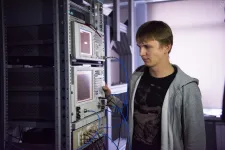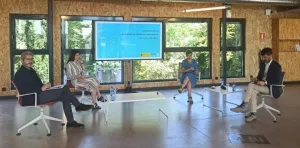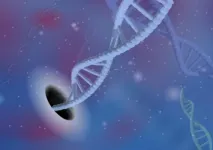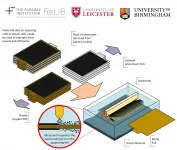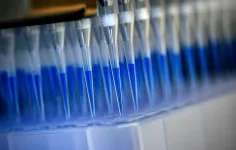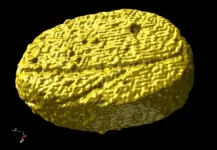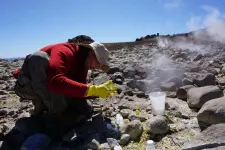INFORMATION:
Scientists discover new type of quasiparticle
2021-06-29
(Press-News.org) Russian scientists have experimentally proved the existence of a new type of quasiparticle - previously unknown excitations of coupled pairs of photons in qubit chains. This discovery could be a step towards disorder-robust quantum metamaterials. The study was published in Physical Review B.
Superconducting qubits are a leading qubit modality today that is currently being pursued by industry and academia for quantum computing applications. However, the performance of quantum computers is largely affected by decoherence that contributes to a qubits extremely short lifespan and causes computational errors. Another major challenge is low controllability of large qubit arrays.
Metamaterial quantum simulators provide an alternative approach to quantum computing, as they do not require a large amount of control electronics. The idea behind this approach is to create artificial matter out of qubits, the physics of which will obey the same equations as for some real matter. Conversely, you can program the simulator in such a way as to embody matter with properties that have not yet been discovered in nature.
Arrays of superconducting qubits are generally described by the Bose-Hubbard model. An interesting feature of the Bose-Hubbard model is the emergence of bound boson pairs (doublons) caused by the strong quantum nonlinearity. The topological physics of doublons has been extensively explored in a series of recent theoretical works. However, the experimental investigation of topological properties of bound photon pairs is still lacking.
A group of scientists from NUST MISIS, Russian Quantum Center, ITMO University, Bauman Moscow State Technical University, Dukhov Automatics Research Institute (VNIIA) and Ioffe Institute used an array of superconducting qubits to engineer a quantum simulator. Quantum utilize entanglement and many-particle behaviors to explore and solve hard scientific, engineering, and computational problems.
"By registering the properties of qubits, we can draw conclusions about a broader class of physical systems described by the same equations. And if we can change the parameters of these equations in a controlled way, then such a device can be considered a "specialized simulator". Of course, its programmability is not the same as that of a quantum computer, but its scaling requires significantly fewer resources," explains the main author of the study Ilya Besedin, junior researcher at the NUST MISIS Laboratory of Superconducting Metamaterials.
The scientists engineered an array of superconducting transmon qubits with alternating coupling. Due to the alternation of strong and weak bonds, two zones and an edge state appear in this system. This state is classified as topological. Moreover, the experiment shows that doublons also form an edge state.
"We were able to see how doublons form these zones, and we even managed to detect how an edge doublon state appeared at the upper edge of the doublon zone as we increased the length of the array," notes Ilya Besedin.
Thus, the scientists were able to demonstrate for the first time that a new type of quasiparticles - doublon topological excitations - can arise in qubit chains.
"Research on superconducting qubits and quantum circuits is currently underway in many countries around the world, and competition in this area is growing. This study on 11 qubits shows that Russia has attained high level of scientific development in the field of superconducting quantum computing", notes Prof. Alexey Ustinov, Head of the Laboratory for Superconducting Metamaterials at NUST MISIS and Group Head at Russian Quantum Center, who co-authored the study.
ELSE PRESS RELEASES FROM THIS DATE:
Microbes feast on crushed rock in subglacial lakes beneath Antarctica
2021-06-29
Pioneering research has revealed the erosion of ancient sediments found deep beneath Antarctic ice could be a vital and previously unknown source of nutrients and energy for abundant microbial life.
The study, led by the University of Bristol and published today in Nature's Communications Earth & Environment journal, sheds new light on the many compounds supporting various microbes which form part of a huge subglacial ecosystem.
Lead author Dr Beatriz Gill Olivas, a Post-Doctoral Research Associate at the University of Bristol, said: "Although the study focused on samples obtained from a single ...
Scientists observe the dynamics behind the exceptional summer 2020 Yangtze River rainfall seasonal projections
2021-06-29
During summer 2020, the Yangtze River basin experienced persistent, record-breaking meiyu rainfall. Likewise, the region suffered from severe flooding and water damage as accumulated rainfall broke records dating back to 1954. Regions outside the meiyu rain belt received significant summer rainfall as well, including Beijing, located in northeastern China.
Typically, an above average meiyu rainfall season follows a strong El Niño during the previous winter. However, summer 2020 followed a neutral El Niño-Southern Oscillation (ENSO) event. Therefore, scientists are working ...
How environmental factors could provide for a young brain
2021-06-29
A stimulating environment keeps the "hippocampus" - which is the brain's memory control center - young, so to speak. Causes of this are molecular mechanisms that affect gene regulation. These current findings from studies in mice provide clues as to why an active, varied life can help preserve mental fitness in old age. Researchers from the DZNE and the Center for Regenerative Therapies Dresden (CRTD) at the Technische Universität Dresden report on this in the journal Nature Communications.
Human DNA - and this also applies to mice - contains thousands of genes. However, it is not only the genetic blueprint that is decisive for the function of a cell and whether it is healthy or not, but above all which genes can be switched on or off. ...
83% of the Spanish population trusts in vaccination against COVID, 25 points more than in January
2021-06-29
FECYT - Spanish Foundation for Science and Technology - presented today at the headquarters of the National Museum of Science and Technology, MUNCYT, IN Alcobendas, the results of the third Social Perception Survey of scientific aspects of the COVID-19 in a debate moderated by Pampa García Molina, Editor-in-Chief of the SINC Agency, in which Raquel Yotti, Director of the Carlos III Health Institute of Madrid, Josep Lobera, Professor of Sociology at the Universidad Autónoma de Madrid (UAM) and scientific director of the Social Perception Survey on the scientific aspects of COVID-19 and ...
Through the nano hole: lego technique reveals the physics of DNA transport through nanopores
2021-06-29
Polymers are long, chain-like molecules which are everywhere in biology. DNA and RNA are polymers formed by many consecutive copies of nucleotides coupled together. When being transported within or between cells, these biological polymers must pass through nanometre-sized holes called "nanopores".
This process also underlies a rapidly developing method for analysing and sequencing DNA called nanopore sensing.
The study, published in the journal END ...
Leicester expert leads ground breaking invention on battery recycling
2021-06-29
Researchers at the University of Leicester have developed a new method to recycle electric vehicle batteries using a ground-breaking new approach that many will have experienced in the dentist's chair.
The Faraday Institution project on the recycling of lithium-ion batteries (ReLiB) led by Professor Andy Abbott at the University of Leicester used a new method, involving ultrasonic waves, to solve a critical challenge: how to separate out valuable materials from electrodes so that the materials can be fully recovered from batteries at the end of their life.
Current recycling ...
New corona mass test up to 100 times more sensitive than rapid antigen tests
2021-06-29
A new corona test developed at the University Hospital Bonn can analyze a large number of swabs simultaneously using sequencing technology and has a similarly high sensitivity as the common qPCR test. The innovative method offers great potential, especially for systematic testing in daycare centers, schools or companies. Today, the results of the study on the new Corona test have been published in the renowned journal "Nature Biotechnology".
Bonn, 6/29/2021 - In addition to vaccination, systematic testing of the population remains of central importance in order to effectively monitor and contain the spread of infections during the Coronavirus pandemic. Only in this way can the spread of the virus be effectively monitored and ...
This crystal impurity is sheer perfection
2021-06-29
Crystallization is one of the most fundamental processes found in nature - and it's what gives minerals, gems, metals, and even proteins their structure.
In the past couple of decades, scientists have tried to uncover how natural crystals self-assemble and grow - and their pioneering work has led to some exciting new technologies - from the quantum dots behind colorful QLED TV displays, to peptoids, a protein-mimic that has inspired dozens of biotech breakthroughs.
Now, a research team led by scientists at the Department of Energy's Lawrence Berkeley National Laboratory (Berkeley Lab) and UC Berkeley has developed a nanoparticle composite that grows ...
Stretching changes the electronic properties of graphene
2021-06-29
The electronic properties of graphene can be specifically modified by stretching the material evenly, say researchers at the University of Basel. These results open the door to the development of new types of electronic components.
Graphene consists of a single layer of carbon atoms arranged in a hexagonal lattice. The material is very flexible and has excellent electronic properties, making it attractive for numerous applications - electronic components in particular.
Researchers led by Professor Christian Schönenberger at the Swiss Nanoscience Institute and the Department of Physics at the University of Basel have now studied how the material's ...
Sustainable mining of raw materials from thermal springs in Chile
2021-06-29
Mineral resources from Chile are of great importance to Germany. According to statistics from the World Bank, thousands of tons of valuable minerals are imported from the South American country every year, including raw materials for lithium-ion batteries. But their extraction causes ecological and social problems: "The use of the limited freshwater resources in northern Chile for mining regularly fuels conflicts with the local population," says Professor Thomas Kohl from KIT's Institute of Applied Geosciences (AGW). "Northern Chile is one of the driest regions on earth, but has extensive geothermal resources. With a novel type of plant, it is not only possible to generate electricity in a climate-friendly way, but also to extract ...
